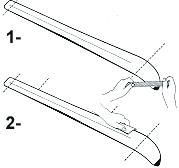A good driver takes very good care of his or her car to get the peak performance from it, and to get the most of your ski equipment, you should take care of them too. Some ski maintenance can be the do-it-yourself variety, while other care is best left to a ski shop. Below you will find tips for maintaining your bindings, boots and all what you need to know for maintaining your skis:

Keep them clean at all times because road salt and dirt will corrode your bindings and may cause them to malfunction. When storing your equipment for the summer, turn down your release settings. This will keep your release settings consistent for a longer period of time. Have your bindings checked by your local ski shop at least once a year (more often if you ski a lot) to make sure that they are functioning properly; or you may test them yourself by forcing the release.

Make sure your boots are buckled up after use. Make sure the various layers are folded over each other correctly. This will help them keep their shape and remain comfortable. Make sure your boots are dried out after using them. They will be warmer on your feet the next day. Keep your boot soles clean and free of dirt. Try not wear down the heels and toes of your boots. A clean unworn boot will release more consistently from your bindings.

Wipe your skis down after skiing. The edges will rust if you do not because they are made of high carbon steel. Store your skis in a dry area. Do not lean them against hot pipes or on concrete floors. For summer storage, it is best to use a light coating of oil on the edges of skis to prevent rust. Waxing, edge sharpening and base repair are the 3 most important parts of the tuning process. Experts know that the new shaped skis are even more tune-sensitive than traditional boards. Untuned or badly tuned skis don’t perform well. If your skis hook, grab, or catch while you are skiing, if the edges won’t grip on hard pack, if they feel unstable at higher speeds, or if they are difficult to ski at higher speeds, they need to be looked at and worked on.
Waxing:
At the very least, you should wax your ski bases. Waxing not only will make your skis turn more smoothly, but also will increase your skis’ useful life by protecting their bases from abrasion by the snow or even from oxidation by the sun’s ultraviolet rays. Wax is rubbed or melted and smoothed onto the bases of your skis. You can do this yourself. The easiest quick-and-dirty method is to rub a cake wax, paste wax, or liquid wax over the ski base. When you begin skiing, it will be distributed over the running surface, but it wears off quickly. You can learn to hot-wax your own skis, using an iron or special waxing device. At some ski areas, you can simply ski over a coin operated waxer right on the slops. Hot wax lasts a lot longer than rub-on wax. You can also take your skis to a shop and have them hot-waxed. The least expensive hot waxing is to run the ski over a roller that applies the melted wax, similar to the ski-through system you may find on a mountain. However, in a shop, the excess is allowed to cool and then scraped off. The best method is to iron the wax onto the ski. The heat of the iron not only melt the wax, but it also opens the pores of the ski’s base material, allowing absorption of the wax, which is then scraped.
Did you know that... wax helps you turn and glide not because it is slippery, but because it is water-repellent. When you ski, the friction of the ski base creates a light film of water that actually reduces glide ability. A layer of wax on the ski base breaks the film up into small beads of water, enabling the ski to turn more easily.
Edge Sharpening:
 Even though they are made of steel, ski edges are vulnerable to little nicks and burrs that can affect your skiing. To check for burrs, run your finger lightly down the edges. If you feel little metal snags, you should deburr the edges. You may use a small inexpensive stone made for this purpose. However, improper sharpening can do more damage to your skiing than not sharpening the skis at all, because overly sharp edges can catch.
Even though they are made of steel, ski edges are vulnerable to little nicks and burrs that can affect your skiing. To check for burrs, run your finger lightly down the edges. If you feel little metal snags, you should deburr the edges. You may use a small inexpensive stone made for this purpose. However, improper sharpening can do more damage to your skiing than not sharpening the skis at all, because overly sharp edges can catch.
1- Edges outside the dashed line must be made smooth and rounded.
2- Edges between the dashed lines should be enough sharpened to obtain a 90 degree square edge.
Base Repair:
Unless you ski nothing but bottomless powder -and most of us don't- you'll inevitably find scratches and whole chunks taken out of your ski bases, and these need to be repaired. Ski shops can fill in damaged spots and smooth them over so that your skis are as good as new, or nearly so. The ultimate damage to a ski is delamination, in which the base or top surface has actually separated from the core material.
Tip Use a ski bag or binding cover when transporting your skis on top of your car. This will help to protect them from road salt and grime.





